Solar Batteries Lifespan: How Long Will Your Deep-Cycle Last?
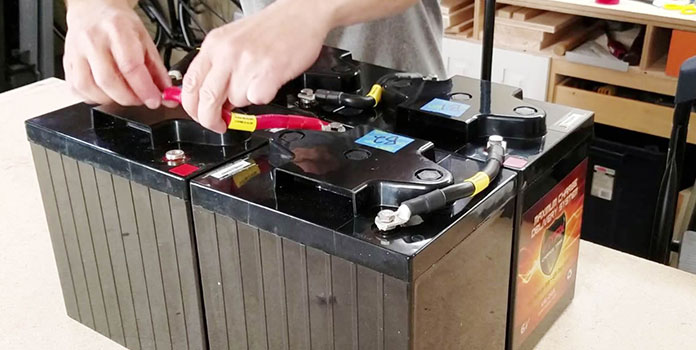
How long do all the different kinds of deep-cycle batteries last?
These days, when most of us are going to make a big purchase, the first thing we all do is go online and research prices. If you’re thinking about adding batteries to your solar installation, you’ve probably already done this.
However, for energy storage at least, that initial purchase price is only half the story. You also need to take into account your solar batteries’ lifespan. After all, if you found a a giant solar battery for $100, but it only lasts 6 months – is it really a good deal?
How long your batteries last, how far you can discharge them, and how to keep them running optimally are all factors to consider before making any decision. If it sounds like a lot, don’t panic! Let’s dive in to all of it now.
What Are Your Options?
There are two main types of batteries available for energy storage: lead-acid and lithium-ion. Lead-acid batteries are far cheaper than lithium, but don’t last nearly as long. On the flip side, lithium batteries can cost an arm and a leg, but can last 8x to 12x longer than lead-acid, so you’ve got more time to recoup your initial investment.
Battery technology, though, isn’t the only thing that affects solar batteries’ lifespan. Temperature, maintenance, and how deeply you discharge your batteries (known as Depth of Discharge) all play a serious role in their lifespan – either keeping them going as long as possible, or helping them conk out after just a few years.
Let’s take a look at the estimated lifespan of the most common battery types for solar backup and some tips to help you lengthen that battery life as long as possible.
Lead-Acid Batteries
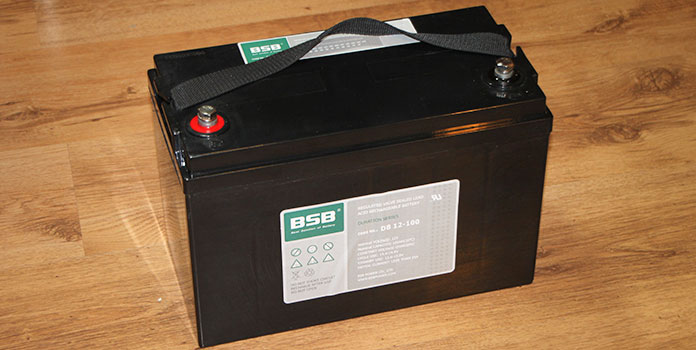
Estimated Lifespan: 5-7 years, though as low as 2 years for the cheapest deep-cycle battery to 10 years+ for high-quality options
Life Cycle: 500 – 1600 cycles (depending on battery type, quality, and average Depth of Discharge)
Upfront Cost: $ out of $$$$
The old standard for off-grid solar installations (and used in most cars), lead-acid batteries are cheap (comparatively) and durable. These batteries create electricity through chemical reaction between lead plates within the battery and sulfuric acid that surrounds the plates, hence the name lead-acid.
There are many different variations of lead-acid batteries for solar backup, from cheap 6v golf cart batteries, to sealed AGM batteries, to large 48v flooded batteries designed for medium- to large-sized installations.
Unfortunately, as most car-owners know, lead-acid batteries are also short lived – typically ranging around 5 to 7 years. To compound that lifespan problem, most experts recommend only using about 30% to 50% of your lead-acid battery’s capacity. Discharging further greatly shortens the life of the batteries.
So why would you buy lead acid batteries? Cost, of course! Take a look at the Trojan T-105RE, a popular deep-cycle battery specially designed for renewable energy backup.
You can purchase this 225 amp-hour 6v battery for about $170 and receive about 1600 cycles at 50% Depth of Discharge. In other words, in good conditions you can use 50% of the battery’s capacity 1600 times. Exactly how long 1600 cycles will last depends on your electricity use. Trojan warranties the T-105RE for 5 years, covering complete replacement for 2 years and a pro-rated credit for the remaining 3 years.
You’ll need 2 to bring the voltage up to a useful 12 volts. Even still, if a single Trojan battery costs $170 and it will provide 180,000 amp-hours over its life (225 Ah X 50% X 1600 cycles), your $/AH cost breaks down to $0.19 per 100 AH:
Is that any good? Let’s compare with the other batteries below.
Bottom Line: Lead-acid batteries are the cheapest option for solar backup, but suffer from shorter lifespan and low DoD.
Lithium-Ion Batteries
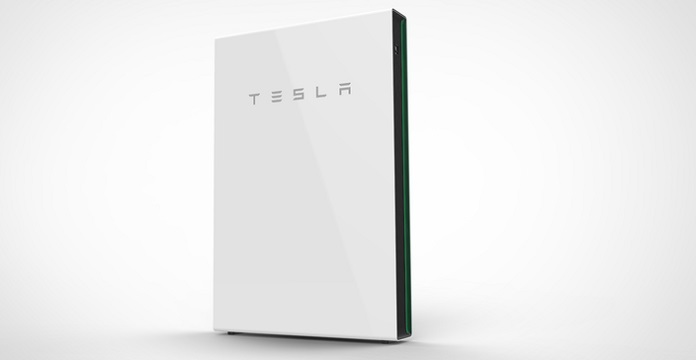
Estimated Lifespan: 10 to 15 years
Cycles: 10,000+ (80% DOD)
Upfront Cost: $$$$ out of $$$$
Once only found in smaller devices like cell phones thanks to their extremely high costs, lithium-ion batteries were simply too expensive for large-scale applications like solar.
However, thanks to the burgeoning electric vehicle market, the cost of lithium batteries has dropped to the point where even grid-connected homeowners are finding it cheaper than utility-sourced electricity. And with Tesla’s popular Powerwall, itself powered by lithium-ion batteries, lithium is certainly the cool thing right now in energy storage.
Why are they so cool? So many reasons! First off, they can be half the weight of a similarly sized lead-acid battery. Secondly, they can be discharged down to 80% or so of their total capacity (incredible compared to lead-acid batteries). They’re much faster charging. And lastly, they last much, much longer than their lead-acid brethren.
All of those perks make lithium batteries leaps and bounds above lead-acid. So where’s the problem? Well, you know what’s coming. Lithium-ion batteries are expensive. Very expensive.
Let’s take a look at SimpliPhi’s lithium-iron-phosphate batteries. Their 1352 watt-hour (113 amp-hour), 12V PHI battery offers up to 80% depth of discharge (simply incredible when compared to lead-acid’s recommended 30% to 50%) with an as-incredible 10,000+ cycle life.
At that rate, this battery should last over 600% longer than the Trojan battery above – pretty incredible, right? BUT, this thing costs over $1,500. You read that right. $1,325 more than the Trojan battery. Wow!
Is buying a SimpliPhi battery a better idea than just buying and replacing the Trojan battery as you go?
Deciding if lithium batteries are worth the extra cost entails doing some math to figure out the $/Ah cost of the energy you can pull from the battery over its lifespan. We already know that the Trojan battery above costs about $0.19 per 100 amp-hours, so let’s find the $/AH price for the SimpliPHI battery:
So you can see that, even though the lithium battery costs over $1,000 more than the Trojan battery, over its entire lifespan, you’ll actually spend less with the SimpliPhi. Pretty amazing, right?
Bottom Line: With an ultra-long lifespan and incredible DOD, lithium batteries can be just as cost-effective as cheaper lead-acid batteries. However, they still suffer from high sticker prices.
Nickel Iron Batteries
Estimated Lifespan: 30 years
Cycles: 11,000 (80% DOD)
Cost: $$$$ out of $$$$
Not nearly as popular as lead-acid or lithium batteries, you might be surprised to learn that nickel iron batteries have been around for over 100 years! They don’t use the caustic acid that lead-acid batteries have, so (like lithium batteries) they last much longer.
How much longer? Well, Iron Edison – a major manufacturer of nickel iron batteries – estimates their batteries will last 30 years with proper maintenance. We don’t need to tell you, that’s an incredibly long time!
Very few manufacturers actually make nickel iron batteries, but the National Renewable Energy Lab tested Iron Edison’s batteries and found they actually over-perform during the tests, so these things are for real!
Similar to lithium batteries, nickel iron costs much more than lead-acid up front, but their much longer life cycle means you will get more use out of them. Iron Edison claims that, discharging down to 80% (the same as the lithium batteries above), you’ll still enjoy 11,000 life cycles – 10% more than the lithium batteries. And at just $960 for a 100Ah battery, they come in cheaper as well!
The Trojan battery above costs about $0.19 per 100 Ah and the SimpliPHI battery costs $0.17 per 100 Ah, so let’s see how much a 100 Ah Iron Edison battery costs over the long-term:
Despite its high price, the Iron Edison batteries are by far the most cost-effective batteries on our list, thanks to their ultra-long lifespan and mid-level price.
Bottom Line: Nickel-iron batteries see the longest lifespan of any deep-cycle battery we’ve yet to see. This long life allows their $/Ah cost to drop well below any of the other batteries on our list. If you’re looking for long-lasting, cost-effective batteries, certainly look into these!
Factors that Affect Solar Batteries’ Lifespan
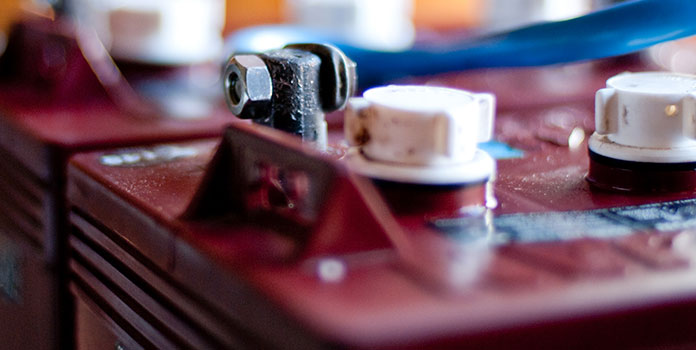
Just like anything, the better you care for your batteries, the longer they’ll last. The battery specs above assume that you maintain your batteries perfectly over their lifetime. In reality, though, there are a handful of considerations that affect the lifespan of solar batteries, including temperature, maintenance, and your regular depth of discharge (DoD).
Use Cycles and Depth of Discharge
We’ve already mentioned this, but the deeper you discharge your battery, the fewer cycles you’ll have over its lifespan. Experts recommend limiting your lead-acid batteries to around 30% to 50% DOD, while lithium-ion and nickel-iron can go as low as 80% without affecting the total number of cycles too much (see the batteries’ spec sheets above to the see the relationship between DoD and cycle life).
Choosing exactly how many batteries you need and how far you will discharge them is, to an extent, a balancing act between upfront costs and long-term value. You can buy a smaller number of batteries and simply discharge them more deeply, but it is better financially to follow the experts’ recommendations for your battery type.
Ambient Temperature
Temperature – both highs and lows – greatly affect your battery’s performance and life expectancy. High temperatures allow the chemical reactions to occur more quickly and improve performance, but that same high performance causes faster degradation of the battery itself and forces a shorter lifespan.
In the spec sheet (linked to above) for their T-105RE, battery manufacturer Trojan warns that, for every additional 10°C that the temperature increases, the reaction rate doubles. In essence, that 10 degree difference causes 2x the wear! They say it best: “Heat is an enemy of all lead acid batteries, FLA, AGM and gel alike and even small increases in temperature will have a major influence on battery life.”
And, while the T-105RE’s operating temperature is -4°F to 113°F, keeping lead-acid batteries closer to 40° to 80°F will greatly prolong their lifespan. The same goes for any battery, though lithium batteries can handle higher temps than lead-acid. The SimpliPhi batteries above, for example, can operate in -4°F to 140°F. That’s almost 30°F higher than the T-105RE and a huge benefit to those of us in extremely hot climates.
Maintenance
Regularly maintaining your batteries is a huge step in keeping them in tip-top shape. With lead-acid batteries, check the water levels every couple months and adding more if needed is crucial. For flooded lead-acid batteries (and any batteries that aren’t sealed), clean the terminals to ensure good connections.
And of course, for all types of batteries, ensure that your batteries aren’t uncharged (or overcharged) for extended periods of time, as empty (or bursting) batteries can quickly damage.
No matter what you choose, battery backup gives you energy options
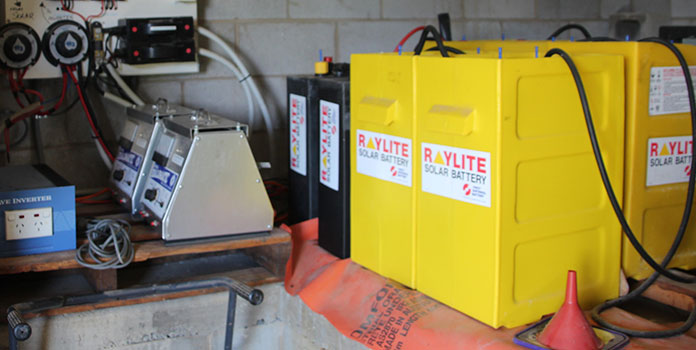
Whether you’re connected to the grid or not, batteries allow you to increase your self-reliance and take one step further from the grid. If you’re serious about installing a solar backup system, talk to a local installer that specializes in solar+storage for cost estimates and long-term savings analysis, as they’ll know what to expect for your specific area.
As with anything in life, the better you take care of this expensive piece of equipment, the longer it will keep your home powered.
Do you have any storage attached to your solar installation? Tell us about it in the comments below!
Image Credits: CC License via Flickr – 1, 2, 4, 5 & Tesla Presskit – 3

